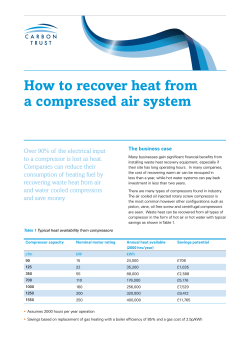
How to Better Provide Domestic Water Heating by Clement Silavwe ZESCO LtD
How to Better Provide Domestic Water Heating by Clement Silavwe ZESCO LtD 1 Introduction Currently some PIESA countries are using up to 45% of the Residential sector electricity needs on heating up water. Historically, this has been acceptable due to abundance of cheap electricity A few countries recognised the savings that can be made in terms of energy security from careful control of this end use demand for MD control. How to Better Provide Domestic Water Heating C. Silavwe PIESA 2011 Lilongwe 2 Introduction (Cont’d.) Times have changed: we now have electricity rationing massive rural electrification efforts scarce financing for major electricity infrastructure the ripple control schemes alone may not suffice. We must go back to the fundamental questions of what is it is that ultimately we are delivering as a service. How to Better Provide Domestic Water Heating C. Silavwe PIESA 2011 Lilongwe 3 Energy Provision & Demand For domestic hot water, it is here proposed that in fact instead of just control we could do an entire energy switch to solar heating as our region is well endowed with solar irradiation. Using an Integrated Energy Resource Planning approach, we shall briefly look at: The overall picture of energy supply demand in selected PIESA countries The summary of general financing of energy sector Availability of RE resources How to Better Provide Domestic Water Heating C. Silavwe PIESA 2011 Lilongwe 4 Energy Provision & Demand (Cont’d.) Use of solar energy for heating The Zesco Solar Geyser Programme Possible Rebound Effect Standards Conclusion How to Better Provide Domestic Water Heating C. Silavwe PIESA 2011 Lilongwe 5 Fig. 1, Final Energy Consumption from PIESA Countries Adapted fromB. Merven, A. Hughes & S. Davies – ERC, Cape Town Journal of Energy in Southern Africa • Vol 21 No 1 • February 2010 6 Availability of Renewable Energy Resources in Selected PIESA Countries Country Small Hydro Angola Potential 152 TWh/a Fuel wood, up to 1020 mill cubic m/a) Poor-average Solar (kWh) Irradiation 4-7 Botswana No hydropower Poor 5-7 DRC Lesotho 100 GW potential Potential for 3GW pumped storage Fuel wood, current not sustainable 122 mill ha of forest Pot.: Fuel wood (39,000 ha) Poor 20MW potential 3-6 Av. 5.5 Madagascar Potential of 49 000 GWh/year Estimated potential of 900MW Forest area of 12 800 ha Ethanol (7% of liquid fuel, 12 million litres pa) Bagasse, fuel wood and charcoal 3.5 – 4 bill tonnes Good along the coast Poor 4-6 Good Av 6 Average 4-6, av 5.2 Malawi Mauritius Biomass 59MW existing, almost fully tapped Mozambique 14GW potential (18%developed) Wind Potential How to Better Provide Domestic Water Heating C. Silavwe PIESA 2011 Lilongwe 4-6, av 5.8 7 Availability of Renewable Energy Resources in Selected PIESA Countries Country Small Hydro Biomass Wind Potential Namibia Hydro potential along the borders 668MW installed capacity Abundant in north scarce in south Bagasse, fuel wood Good along the coast Good capacity factor >25%.3 Swaziland 300 GWh/a 30% developed Ptential from bagasse, Poor 25 tapped 4-6 Tanzania Potential 4.7GW 12% developed Fuel wood forests and Good along the plantations coast 4-7 Zambia 6,600MW at various sites Possible 37TWh, 25% harnessed Fuel wood and charcoal 13 mill tonnes fuel wood Poor 4 -7 Poor 5-7 South Africa Zimbabwe How to Better Provide Domestic Water Heating C. Silavwe PIESA 2011 Lilongwe Solar (kWh) Irradiation 5-8, av 6 4-8 8 Fig. 2, Usage Vs. Investment for RETs in a Typical PIESA Country Adapted from(6) Energy Use in a Typical PIESA Country Energy Investment in a Typical PIESA Country Large Scale Technologies Large Scale Technologies Small Scale & Renewable Energy Technologies Mainly used by the non_poor or big industry 9 Fig. 3, Energy Efficiency possible for Water Heating from Various Sources T&D 80% Electric Geyser 75% Hot Water Solar Geyser 50% Generator 80% ~14% Collector Diesel Engine 30% Fuel Solar Radiation Fuel Extraction & Refining How to Better Provide Domestic Water Heating C. Silavwe PIESA 2011 Lilongwe 10 Fig. 4 Life Cycle Effects of Solar Heater Oil Field Waste Energy/Emissions Mining/ agriculture Manufacture. Recycling Reuse Overheated Plastic Fumes Use/ Operation Land Fill? Disposal Reuse How to Better Provide Domestic Water Heating C. Silavwe PIESA 2011 Lilongwe 11 Solar Thermal Heaters - Installed Country Installed Capacity (m.sq.) Botswana 50 Malawi 4.8 Mauritius 40 Namibia South africa Zimbabwe Zambia 24 500 10 100(350) How to Better Provide Domestic Water Heating C. Silavwe PIESA 2011 Lilongwe 12 Flat Plate Collector DSWH How to Better Provide Domestic Water Heating C. Silavwe PIESA 2011 Lilongwe 13 General Principle of Operation (Adapted from GL Morrison) Solar irradiation b) a) Incidence angle effects in evacuated tubular arrays a) At normal incidence some radiation is lost by reflection back thru’the tube array b) At high incidence angles all radiation falls on the high efficiency collector surface How to Better Provide Domestic Water Heating C. Silavwe PIESA 2011 Lilongwe 14 General Principle of Operation The principle of solar heat is age old. Any body > 0K emits radiant energy. The solar collector therefore collects from both long wave and short wave radiation. Direct solar insolation is more effective than diffuse long wave irradiation. At inclines of less than 45’, longwave radiation from the ground has little influence on the collector temperature How to Better Provide Domestic Water Heating C. Silavwe PIESA 2011 Lilongwe 15 General Principle of Operation How to Better Provide Domestic Water Heating C. Silavwe PIESA 2011 Lilongwe 16 How to Better Provide Domestic Water Heating C. Silavwe PIESA 2011 Lilongwe 17 General Principle of Operation (Adapted from GL Morrison) Collector Stagnation Temperature, ‘C Unglazed Black Flat Plate Selective Flat Plate Evacuate Tubular 70 150 190 >300 ISO 9802(1995) defines extreme ambient conditions that solar collectors Should be able to withstand for satisfactory performance in different climates e.g. 1200W/m2 and 40’C for clear dry climates How to Better Provide Domestic Water Heating C. Silavwe PIESA 2011 Lilongwe 18 Effect of load pattern on energy delivery on a horizontal solar heater 40 20 0 Load ( Tank Volumes/ Day) 19 Observed DSM Rebound Effect Study Focus of the Study Greene (1992) Greening et al. (2000) Jones (1993) Khazzoom (1987) Murck et al. (1985) Vehicle efficiency improvement in US Space cooling (based on 35 case studies in various countries) Passenger vehicle use and rebound effect in US Use of energy efficient appliances in US Policy simulation to reduce wood use in Sudan Efficient lighting in households (based on 4 case studies) Water heating based on 5 case studies Ronald and Energy conservation in commercial/household Haugland (1994) sectors in Norway Zein-Elabdin (1997) Improved stoves programs in Sub-Saharan Africa How to Better Provide Domestic Water Heating C. Silavwe Rebound Effect (%) 5-15 PIESA 2011 Lilongwe 10-50 60 75 48 5-12 10-40 10-40 50 20 SOLAR HEATER PERFORMANCE TESTING Materials for key components on solar heaters Cover Materials Polycarbonate, PET, Perspex, Teflon, Uvex Collector Materials Black cobalt, black nickel, black CuO, anodized Al Absorber Materials HDPE, EDPM, PVC, PC, Cu, Fe, Al The Standards ISO 12952 (2000) Absorber Surface Durability Assessment ISO 9495 (2000) Ageing Test to Assess Transparent Covers under Stagnant Conditions ISO 9553 (1997) Assessment of Performed Rubber Seals & Sealing Compounds used in Connectors ISO 9808 (1990) Assessment of Elastomeric Materials for Absorbers, Connecting Pipes & Fittings ISO/TR10217 (1989) Guide to Material Selection for Solar Water Heating Schemes with Regard to Internal Corrosion & several others in the ISO 9800 series that cover thermal shock, rain penetration, impact resistance etc 21 Conclusion • It is practical in the PIESA region to do away with electrical water heating entirely – in the process • save a lot of energy, • create jobs • enhance energy security. • The concept should rest on the three pillars sustainable development: social economic, and the environment linked by effective government institutions. How to Better Provide Domestic Water Heating C. Silavwe PIESA 2011 Lilongwe 22 Conclusion • What are needed are realistic guidelines towards these aspirations. – Energy security policies that take advantage of locally available primary energy resources – In many cases data available from the weather stations in the their current form may not be sufficient to help realise these goals – The fact that the benefits realised may not exactly match with the projections should not discourage the doers from starting; • it should instead be a call to fine tune and sensitise the populace. How to Better Provide Domestic Water Heating C. Silavwe PIESA 2011 Lilongwe 23 References 1. Tools & Methods for Integrated Resource Planning, JN Swisher, GM Jannuzi, RY Redlinger – UNEP 1997 2. Solar Collectors & Solar Water Heating, GL Morrisson 3. An analysis of energy consumption for a selection of countries in the Southern African Development Community, B. Merven, A. Hughes & S. Davies– ERC, Cape Town Journal of Energy in Southern Africa • Vol 21 No 1 • February 2010 4. www.afriwea.org/en/country.htm,www.geni.org. 5. Khazzoom (1987) 6. Renewables in Africa, S Kartekezi,J Kimani & A Wambile AFRENPREN/FWD– Nairobi, Kenya 7. A mobile solar water heater for rural housing in Southern Africa , MN Nieuwoudt & EH Mathews NW University RSA, Science Direct 2004 8. www.zesco.co.zm How to Better Provide Domestic Water Heating C. Silavwe PIESA 2011 Lilongwe 24
© Copyright 2025











